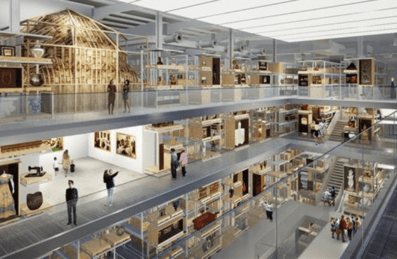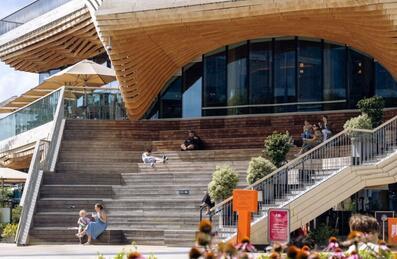
Popular Searches:
Keep up to date
Sign up today for exclusive offers and incredible experiences you won’t want to miss at Queen Elizabeth Olympic Park.
Sign up nowLondon’s Paralympic legacy paved the way for extraordinary and significant change
London’s Paralympic legacy paved the way for extraordinary and significant change
Press Release 25/08/2021
As the opening ceremony of the Paralympic Games gets underway in Tokyo, the three founders from the Global Disability Innovation Hub which is based at Queen Elizabeth Olympic Park talk about their memories of London 2012, the legacy it has left and how that glorious summer paved the way for a major shift in how disability and disabled sports is perceived.
Vicki Austin, Co-Founder and CEO of GDI Hub
When we all witnessed what happened at the Paralympic Games in London 2012 anyone who was even an observer of that felt something shift in terms of the way we view disability. I remember my boss at the time saying to me ‘wow, there are people with disabilities all over the streets of Stratford and it feels inclusive’. The diversity was palpable and you felt the change.
I think for me it was the moment when I looked up and I saw that Channel 4 billboard: ‘Thanks for the warm-up,’ it said, and I thought ‘oh yeah, we’re going to do this really differently’! Channel 4 were not going to be apologetic or presenting an image of disability that was sorrowful or sympathetic. It was about sport and competition. It was about heroes. Suddenly for the very first time we had more athletes from more countries than ever before competing on this global stage and a mixed audience of east Londoners and families.
We knew something had shifted and we thought ‘we need to bottle this’. And that’s what we did with GDI, we tried to bottle it, we tried to change the world a little bit. Me, Iain and Cathy said ‘let’s try and change the world a little bit’, to ourselves. And we did, and we have, and we are, and we hope, we’ll continue to do so, but we can’t change the world a lot by ourselves.
However, #WeThe15 can! We are absolutely privileged to be one of those 20 organisations who are leading this campaign which aims to transform the lives of the 1.2 billion people worldwide who live with an impairment over the coming 10 years.
Professor Cathy Holloway, CO-Founder and Academic Director of GDI Hub and Professor at UCL’s Interaction Centre
Q: Cathy, did you ever imagine when you started that the GDI Hub and its work would become a worldwide and global movement?
No. I’m just an academic, I write papers, I try to educate the next generation, I try to invent new technologies that will make the world a bit of a fairer place. But as a child I wanted to change the world. I could never understand why power was used in inappropriate ways. It was always something I cared very deeply about. Social justice is something that has run through my blood for a long time but for me to be able to use what I love to do to make change is a privilege.
What we do at UCL, is to try and create new knowledge and in order to generate new knowledge, and drive impact. You have to bring partners together to do that and what I care about is creating new ways to change societal problems. Evidence suggests that disabled are often the poorest people and I don’t mean that in terms of personality or ability - people are full of abundance and full of ability and yet society sort of wraps straightjackets around that ability and doesn’t allow us all to shine.
Vicki: Under Cathy’s leadership and with the support of the Founding Partners we’ve been able to launch a new Masters programme called Design, Disability and Innovation which is now in its third year, run out of Here East. So, with Loughborough University and the London College of Fashion, we’re teaching students how to do this (disability innovation) for the first time in the world, and we’re getting a bigger and bigger cohorts of interest and alumina. We’ve also published 62 peer review articles on the topic in the last 18 months.
With Loughborough University and the International Paralympic Committee, and with the help of Hogan Lovells, the legal firm that provided free legal advice on the contracting, and the support of UK Athletics, we’re able to screen the Paralympic Games for the first time in 49 additional countries in Sub-Saharan Africa for the first time this year under AT2030 – our flagship UK Aid funded programme.
That means disabled and non-disabled people alike in many, many locations will be able to watch the Paralympic Games this year - and that’s directly thanks to the work of our partners and our teams. We’re really excited because we know that stigma being experienced by individuals with impairments in communities can be overturned. It’s not a simple fix, but watching amazing athletes perform in Tokyo can going to make a difference. Loughborough are helping us track how that unlearning of stigma really works in practice so we can do more in future.
The job after 2012 was to take the inclusive design standards that we had used (by ODA) for the Games-time and we had to change them quite a lot because how you build a Games park is to put up lots of barriers and have lots of secure areas but that’s not how you create an inclusive park of a Global City - which is perhaps the most diverse global city in the world.
I thought we’d done a good job and lots of people were involved in that but what I didn’t realise is that what we had done was so special. I hadn’t realised that when I went internationally and spoke to the World Health Organisation to UNICEF to others that this was a really impressive piece of work which we must share with others.
I thought that engaging disabled people in leading work about disability was standard practice. Not so. I thought that some of the knowledge and technology we’d created was available in other countries but that’s not always the case. So it was kind of an accidental co-founding between me, Iain and Cathy, I’m definitely not the world’s most likely innovator or entrepreneur!
We have recently completed a piece of research retrofitting what was done in London to understand what that model was and you know what we found? We knew it was about setting a mission and I expected it to be ‘okay, London put in our bid for the Paralympic Games that we were going to be inclusive and accessible and that’s where it all started’. No, that’s not the answer. The answer is it started in the communities that knew what was needed way before we put it in the bid.
This is the story of community-driven mission setting, this is the story of community leadership that was backed by politicians and then organisations across the political spectrum. You start with the people who know best and in this case it was disabled east Londoners that knew best. But our message globally is the same - how do we find the people who know best no matter what the project; so whether we’re working with slum dwellers in Sierra Leone; with innovators in Kenya; with communities in Indonesia - and we’re doing all of that - the people that know best are the people that are in receipt of the decision, the policy, the service, the piece of technology. Those are the people who should be leading our thinking in all sectors, and GDI Hub tries to hold space for that globally, which it turns out is innovative.
In ten years’ time when we look back on what we each did over this decade to come what will we be proud of what we’ve achieved for disability and inclusion? Will we be able to tell our children that we did these things to help make the world a better place for the current one billion disabled people that live on our planet and for all of us and for our families because each of us will need inclusive environments and assisted technology at some point of our lives. So what do you want to be able to say in ten years’ time you did now to make the world a fairer place?
Q: What is the importance of inclusive design and its effectiveness at Queen Elizabeth Olympic Park?
Iain McKinnon, Co-Founder and Director of Inclusive Design at GDI Hub
For me, good inclusive design is about how we experience life around us and I think designers have such influence in how things come to be and how we use things and that includes buildings as much as it includes products, services and digital applications. What good inclusive design does is it considers a really wide and diverse range of users which historically has not really been done particularly well if at all and our starting point is with disability and with disabled people and looking at how to design things that work really well for disabled people and what we have found and what industry is beginning to now become aware of is the fact that if you design something really well to work well for disabled people and also thinking about older people then arguably what you end up with is an end product or output that actually works better for everybody.
Q: They say Queen Elizabeth Olympic Park is the most accessible park in the country and effectively that’s all done to you, Ian?
I’d love to say that was the case but no it’s very much a collective effort. I was very, very fortunate in that my role from 2011 was to focus on the legacy of London 2012 so a huge amount of work had been done by many others to ensure the Olympic Park and the venues was designed and built to be accessible and inclusive. That work had been going since probably the very beginning from the bid onwards in 2005. I think to have a very specific Paralympic legacy programme which was led by Vicky, of which I was part of that team, was absolutely unique. I don’t believe that had ever been done before – London was a bit of a gamechanger. And generally in the UK to really embed that process and to champion and prioritise inclusive design in that way and on that scale I don’t believe had been done before.
These extracts were taken from our latest podcast which you can listen to here. It also includes Craig Spence, chief brand and communications officer at the International Paralympic Committee, talking about the IPC’s We the 15 campaign which aims to transform the lives of the 1.2 billion people worldwide who live with a disability who represent 15% of the global population.
You can also read more about the GDI Hub’s work and latest research by clicking here.
Inclusive design
Professor Cathy Holloway, Iain McKinnon and Vicki Austin







